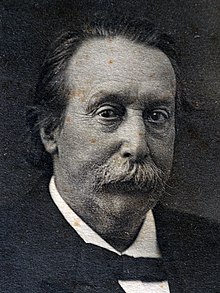Eduard Hagenbach-Bischoff

Eduard Hagenbach-Bischoff (born February 20, 1833 in Basel ; † December 23, 1910 there ) was a Swiss physicist who is known for the electoral process named after him ( Hagenbach-Bischoff process ).
biography
Eduard Hagenbach-Bischoff was the son of the theologian Karl Rudolf Hagenbach . He studied at the University of Basel (with Rudolf Merian ), in Berlin (with Heinrich Wilhelm Dove and Heinrich Gustav Magnus ), Geneva , Paris (with Jules Célestin Jamin ). In 1855 he received his doctorate in Basel . He then taught at the Basel trade school and, after completing his habilitation, was Professor of Mathematics at the University of Basel for a year . From 1863 to 1906 he was a full professor of physics in Basel (successor to Gustav Heinrich Wiedemann ). In 1870 he was the rector of the university. In 1874 he became director of the physical institute at the newly founded Bernoullianum , and from 1874 to 1879 he was president of the Swiss Academy of Natural Sciences .
The head of the building department Rudolf Falkner (1827–1898), the head of the education department Richard Zutt , the president of the trade school commission Eduard Hagenbach as well as the president of the trade museum commission, the banker and politician Louis La Roche (1852–1920) had decisive roles contributed to the realization of the Basel Trade Museum, inaugurated in 1892 .
Hagenbach-Bischoff wrote about 60 papers, namely on viscosity (1860), the carbonic acid content of the atmosphere (1868), fluorescence (1869), the propagation of electricity in the telegraph wire (1886), glacier science (report on the 25-year measurement of the Rhone glacier , 1899 ) and the history of the natural sciences. Hagenbach-Bischoff was particularly committed to popularizing science and gave over 100 lectures at the Bernoullianum for an interested audience without in-depth specialist knowledge, in 1896, for example, about the recently discovered X-rays . Rudolf Brefin was one of his students .
In 1919 the sculptor Jakob Probst created a portrait bust out of white marble for Hagenbach. This is set up in the Bernoullianum. His chair was taken over in 1906 by his son August Hagenbach (1871-1949), whose field of work was spectroscopy .
Family grave, Wolfgottesacker
Memorial plaque at the former Basel industrial museum
literature
- Henri Veillon : Words of Memory of Eduard Hagenbach-Bischoff. Basel 1911 ( Negotiations of the Natural Research Society in Basel . Vol. XXII), pp. 46–53 ( online ).
- Friedrich Zschokke : Professor Eduard Hagenbach-Bischoff. In: Basler Jahrbuch 1912, pp. 146–191.
- Paul Huber: Hagenbach, Jakob Eduard. In: New German Biography (NDB). Volume 7, Duncker & Humblot, Berlin 1966, ISBN 3-428-00188-5 , p. 485 f. ( Digitized version ).
- Monika Dommann : Review, insight, caution. A History of X-Rays 1896–1963. Chronos-Verlag, Zurich 2003 ( PDF; 3.3 MB ).
Web links
- Katharina Huber: Eduard Hagenbach-Bischoff. In: Historical Lexicon of Switzerland .
- Eduard Hagenbach-Bischoff's estate in the Basel University Library
- History of the Physics Department of the University of Basel (PDF; 154 kB)
- Family tree Hagenbach at: stroux.org
Individual evidence
- ↑ See Veillon report. This also contains a list of publications and a photo.
- ↑ according to the list of presidents of the Swiss Academy of Sciences .
- ↑ What is meant is the proportion of carbon dioxide in the air.
- ↑ See Domman, p. 59 and Figure 24 after p. 447
- ↑ See History of the Department of Physics at the University of Basel.
| personal data | |
|---|---|
| SURNAME | Hagenbach-Bischoff, Eduard |
| BRIEF DESCRIPTION | Swiss physicist |
| DATE OF BIRTH | February 20, 1833 |
| PLACE OF BIRTH | Basel |
| DATE OF DEATH | December 23, 1910 |
| Place of death | Basel |


